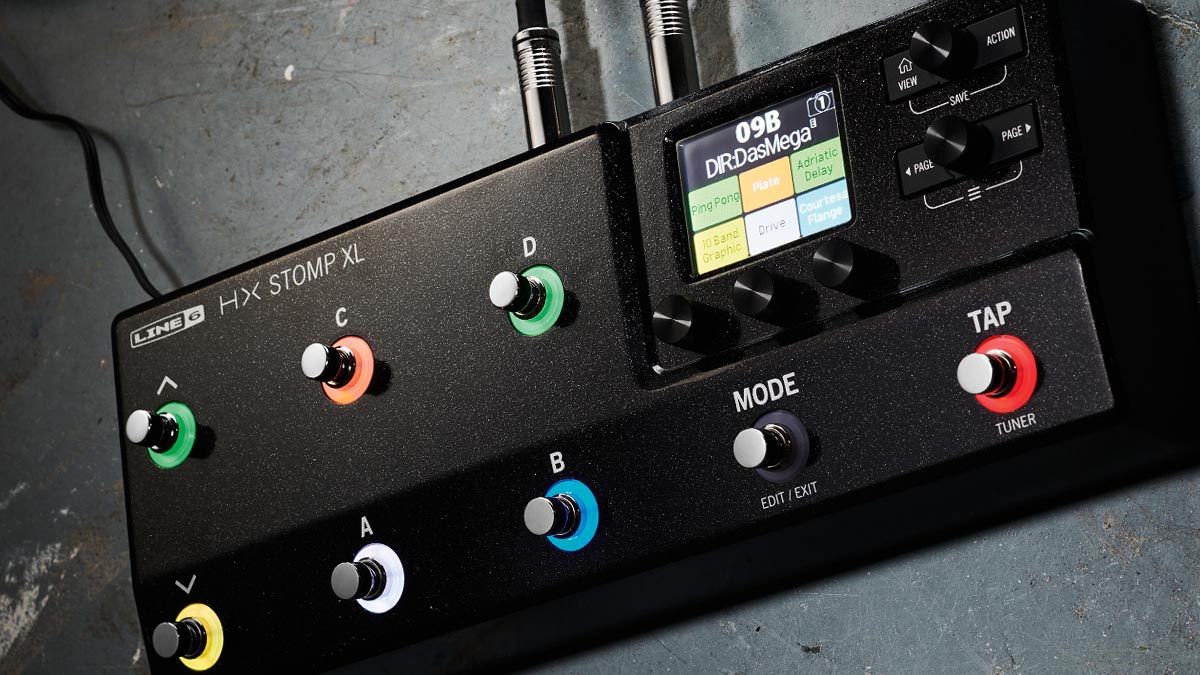MusicRadar Verdict
A sensible, practical and ultimately exhilarating take on the Helix Stomp format, the XL's extra footswitches makes it more naturally suited to live performances than its smaller counterpart and yet it is still respectful of that most precious 21st-century commodity – pedalboard real estate. It's a triumph.
Pros
- +
All the Helix sounds without the price or size.
- +
Super practical.
- +
MIDI compatible with nice range of connection options.
- +
Easy to use.
Cons
- -
Draws a lot of current if using a third party power brick.
- -
If not, the power supply is quite large.
MusicRadar's got your back
Line 6 HX Stomp XL: what is it?
There is something familiar about the Line 6 HX Stomp XL. If you haven't seen one before, just imagine the HX Stomp with an extra five footswitches – still pedalboard-friendly, but offering more switching options, making for a more effective performance tool and fly rig.
As amp modellers and multi-effects processors go, the Stomp XL is right up there in terms of power. It uses the same SHARC digital signal processing and HX modelling engine from the larger Helix units, rendering the same amps, cabs and effects from the same 24-bit/192kHz converters. It can run up to eight processing blocks simultaneously.
Obviously, an eight-footswitch floor unit is bigger than the three-footswitch Stomp, but Line 6 has positioned all the connections on the top of the enclosure, and altogether it takes up about the same footprint as two large multi-functional digital effects from Boss or Strymon. The extra functionality that comes with this expanded yet still compact footprint might well be worth it too.
While the Stomp is unquestionably super-powered when it comes to processing sounds, it lacked a little flexibility when it came to using it live. Sure, there were workarounds to set the footswitches up to serve your setlist, the Stomp XL ups the ante.
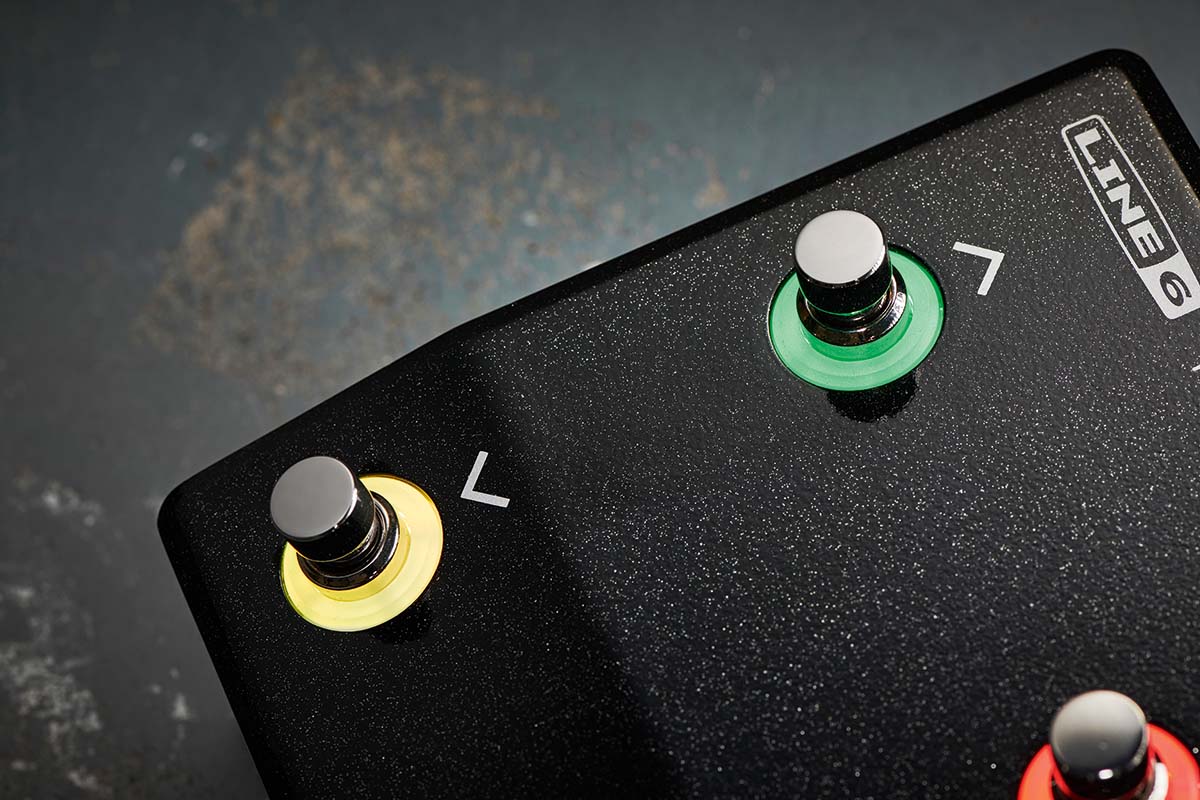
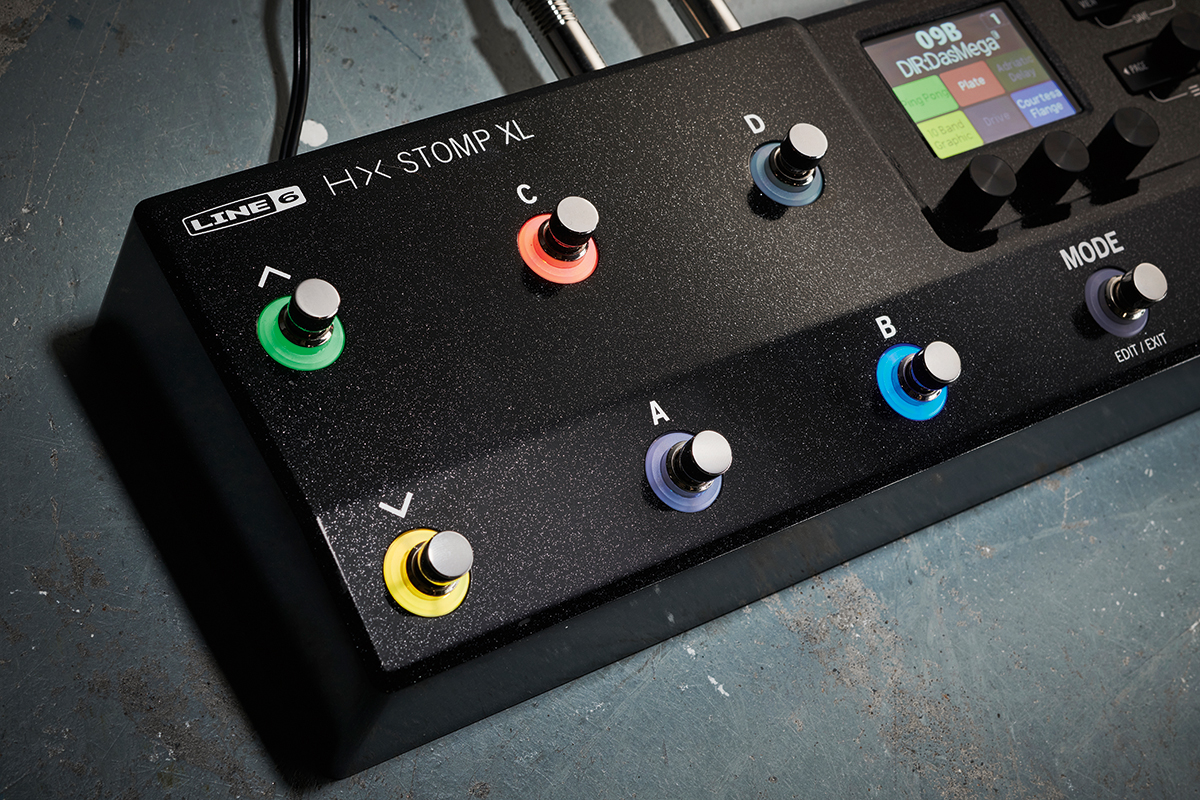
The Stomp XL has two extra presets and now offers four snapshots per preset instead of the Stomp's three. Simply enter Snapshot mode by holding the up/down arrowed footswitches simultaneously, and away you go. Accessing the Stomp XL's features and switching between modes is easy, with the aforementioned arrow footswitches allowing you to scroll through your preset banks,
There is a very useful and fully featured Looper mode in which you can assign looper controls to six footswitches where previously you would have needed an external MIDI controller. But the most practical modes – at least for performance – are Preset and Stomp mode, and these are easily selected by toggling Mode footswitch.
As with many of the controls on the Stomp XL, the Mode footswitch has a secondary function; hold it down and you can enter Pedal Edit mode, which allows you to adjust your presets with the footswitches.
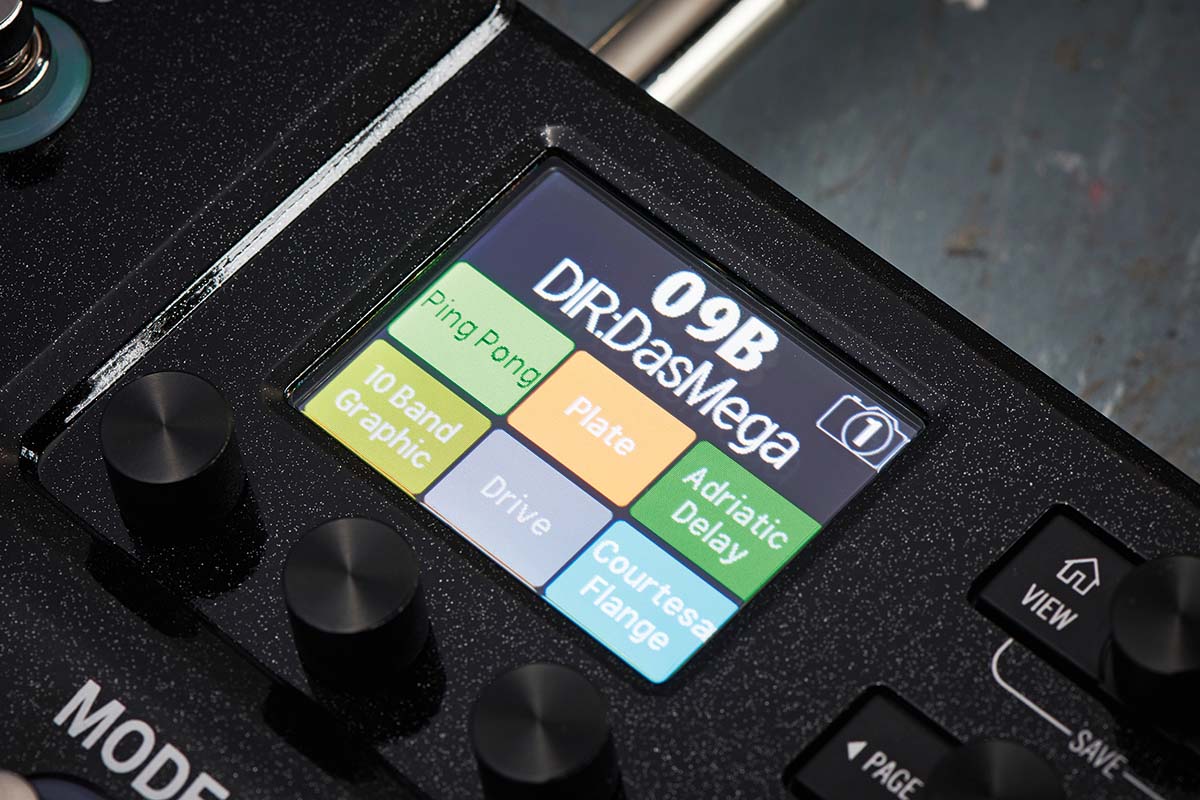
There is, of course, an abundance of sounds already preloaded on the Stomp XL, with some 300-plus HX and legacy amps, cabinet emulations and effects onboard, but you can upload third-party IRs, or incorporate your hardware stompboxes via a stereo effects loop.
Ample opportunity is offered for attaching expression pedals to control parameters on the fly, and while the whole idea of the expanded format of the Stomp XL is to help make performance easier and more flexible, you can also send it directly to your DAW and run the unit as a multi-channel 24-bit/96kHz USB audio interface. The four-cable option allows you to run drives, fuzzes and boosts straight into the front end of your guitar amplifier and place time-based effects in your guitar amplifier's effects loop.
Line 6 HX Stomp XL review: performance and verdict
The Stomp XL is typically well-built. Solid, road-worthy, with an emphasis on intuitive design. The capacitive-touch footswitches with colour-coded LED rings remains an excellent player-friendly design, especially under challenging lighting, while the LED display and controls is nice and clear, and actually might make the Pedal Edit mode, wherein you adjust your presets via the footswitches, largely redundant except for those odd moments when, of course, you really need a hands-free edit option.
Anyway, as with the supreme functionality of the contemporary amp modeller, there are always little features that you never seem use, only to find them one day saving your set.
Getting down to business is simple. We'd wager that Preset and Stomp modes are where you will spend most of your time, with Preset mode allowing you to cycle through banks of your sounds – amps, effects, cabs, etc – and Stomp mode, where the six active footswitches can be assigned a variety of tasks, from turning an effect on an off, cueing up the looper, toggling between sound blocks.
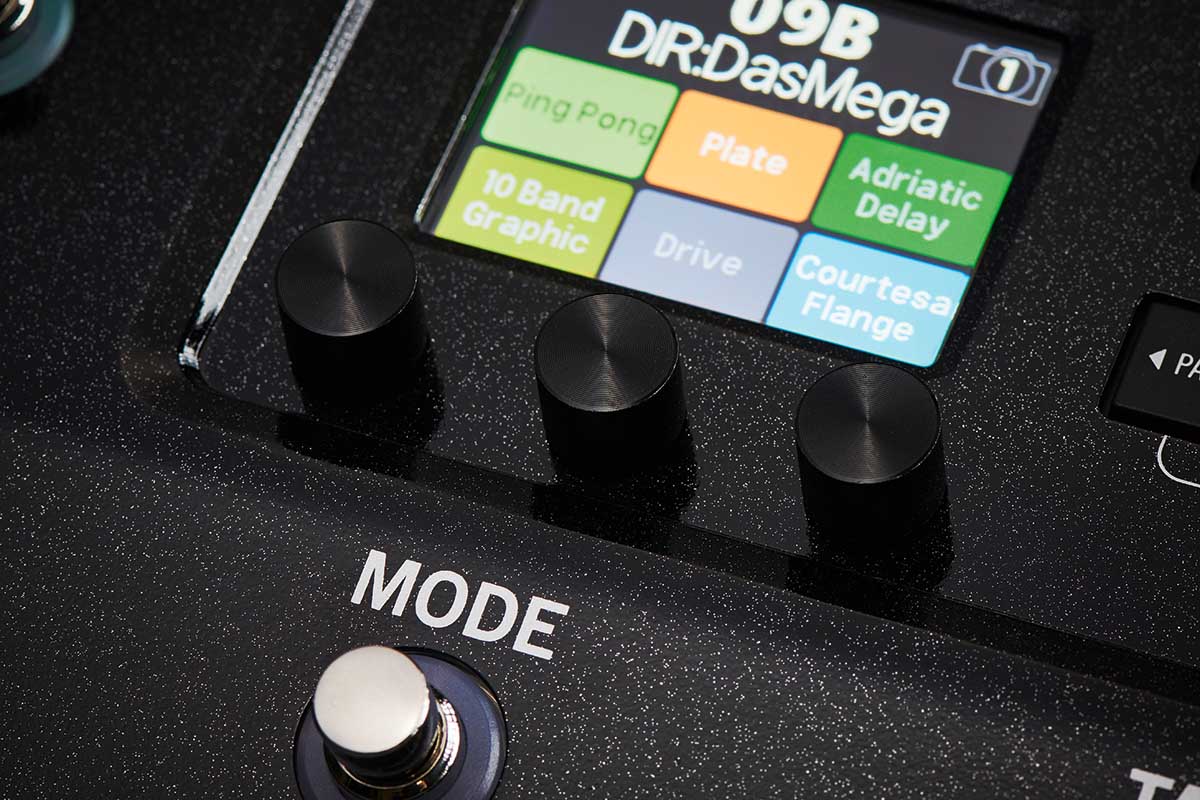
In Stomp Mode, the Play View of the LED screen displays brightly coloured labels that correspond with the footswitches to let you know what is going on when you step on one. Perhaps one could be an octave-fuzz for a chorus riff part, or a weird, spaced-out reverb for an interlude.
You can run Stomp Mode with all six footswitch assignments on the screen or just four, with up/down bank buttons referring you to the up/down arrow footswitches to cycle through your footswitch options. The benefit of the latter being the coloured labels are that bit bigger on the screen. Either way, it's pretty cool.
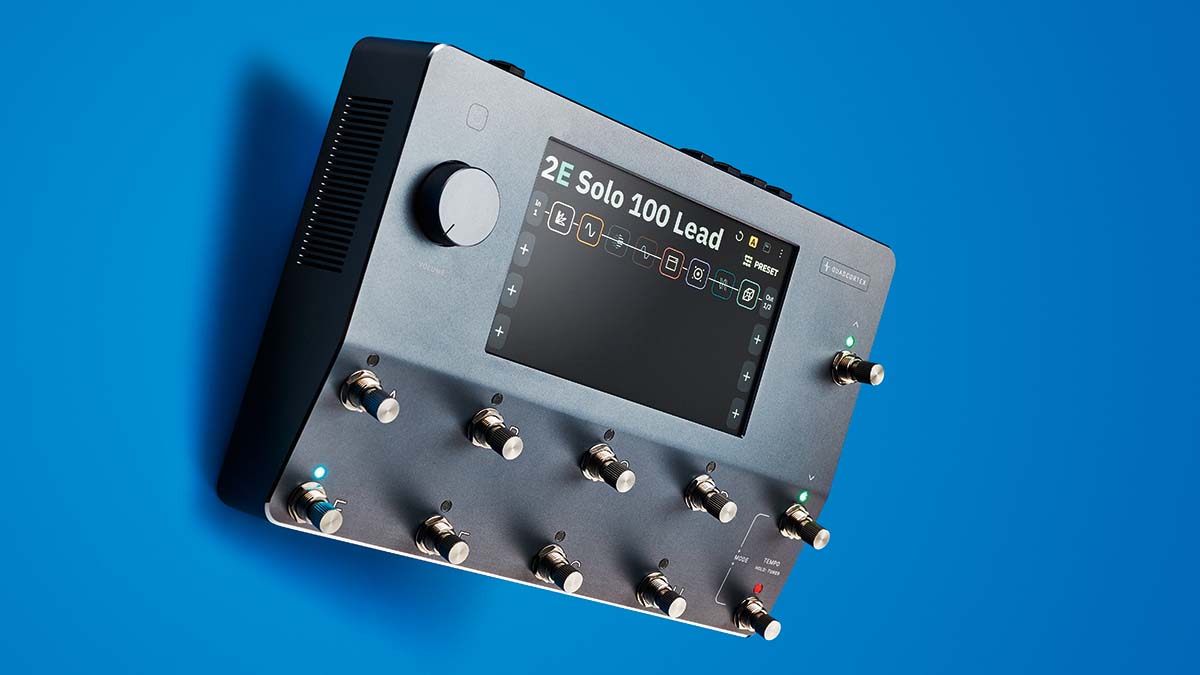
• Neural DSP Quad Cortex
A pro-quality amp modeller and effects unit that presents its many features in an easy-to-use format, the Neural DSP Quad Cortex is a triumph of design. The sound quality is incredible, the user experience unsurpassed. This is the sort of kit to make a digital convert of the most devoutly analogue player.
• Line 6 Helix
While Kemper's Profiler has the ability to mimic the sound of any amp, the Helix offers a more compact and manageable stage experience than the separate head and controller provide. In the same way, it's more practical than an Axe-Fx II, but has a serious rival in the AX8 if you just want a set of sounds simply delivered.
Preset mode maps the four presets per bank to footswitches A to D, and simply go through the banks via the up/down footswitches. When you’ve selected a preset, you can then of course hit the Mode switch enter Stomp mode and play around within that preset's sounds.
Further editing is available via HX Edit software – very useful when using it in a home studio environment, and you can control it via MIDI. Indeed, the Stomp XL could scarcely be more practical. Having heard these sounds from various Helix products, there is no doubting the quality of the amps and effects models, and how the cabinet emulations make this a most versatile fly rig and recording tool. The functionality is what really sells it.
There is a generous complement of connections. Using a splitter cable, the expression/external footswitch input can accommodate both. If you connect the Mission SP1-L6H Line 6 expression pedal (sold separately and priced £/$149 street) it is automatically configured to toggle between wah, pitch-shifting and whammy and volume/pan.
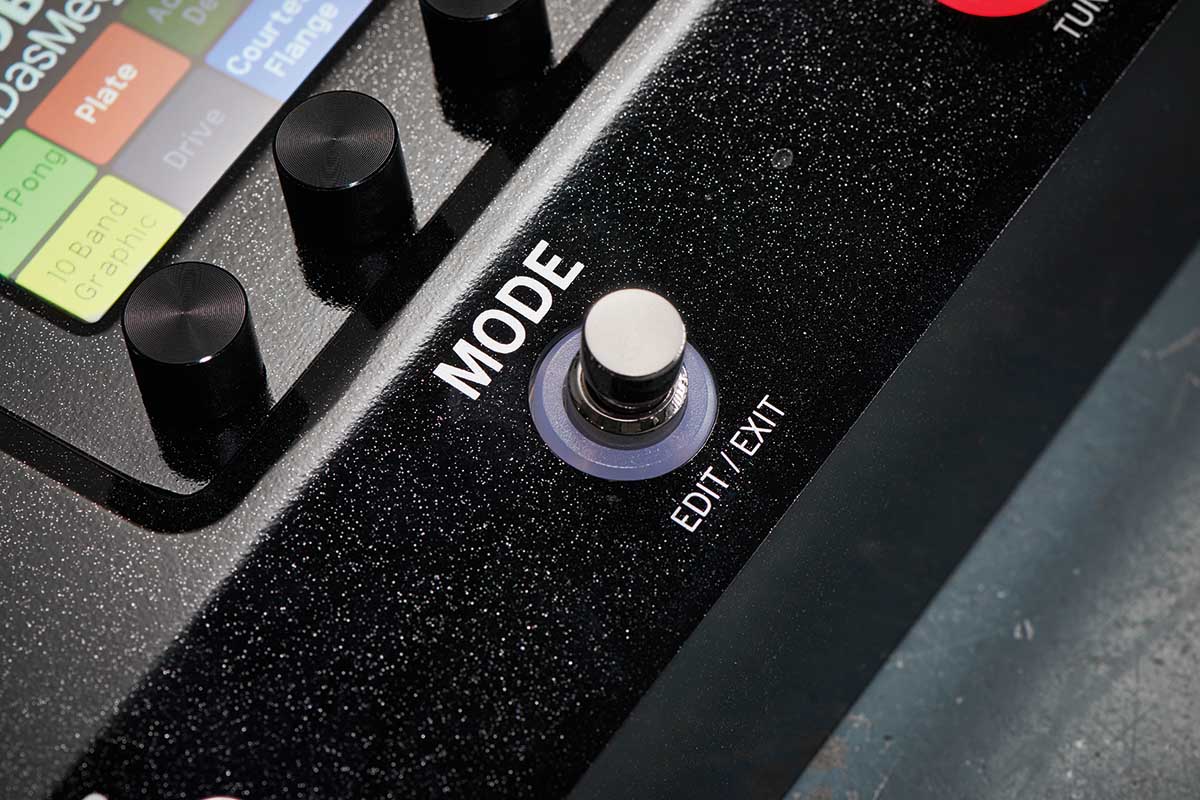
There was never any question over the quality or quantity of the Stomp XL's sounds. These we know are awesome, with all bases covered, but the extension of the Stomp format is a home run for Line 6 because it is simply so flexible and easy to use. The gigging player will appreciate the extra functionality without feeling as though the Stomp has got too big for the pedalboard.
A quick tour of the factory presets is an excellent way to get started and it offers a quite breathtaking sample of the sounds the Stomp XL offers. But of course, tweaking these, making them your own, is a breeze. Typically, with a piece of gear, it is marketed towards a certain type of player. With an amp and effects modeller such as this, players of any genre or style will get a lot of joy out of it.
Session players, or anyone playing to a setlist, will love the ease of use and the logical way Line 6 offers access to the tones. Which of the Helix sizes is the best fit? Well, that's depending on how much you value the supreme portability of the super-compact three-footswitch Stomp, or whether the extra features of the flagship Helix make it a more attractive choice for an all-in-one fly rig. It could well be that this, the middle child, has the best of both worlds.
MusicRadar verdict: A sensible, practical and ultimately exhilarating take on the Helix Stomp format, the XL's extra footswitches makes it more naturally suited to live performances than its smaller counterpart and yet it is still respectful of that most precious 21st-century commodity – pedalboard real estate. It's a triumph.
Line 6 HX Stomp XL review: the web says
"With up to eight blocks (DSP permitting) in a serial signal chain with parallel routing possibilities, and in excess of 300 models to fill them, including more than 80 amps, the unit is capable of a sonic flexibility to suit a wide range of music styles, whether you’re looking for a fully processed composite amp/cab/effects chain or want to set up presets as pedalboards that access a bunch of individual effects."
Guitarist
"The HX Stomp is a much more accessible pedal than the flagship Helix, and the XL makes it more user friendly, especially in a live space. A larger unit makes space for more routing options, and the HX Stomp XL has them in spades.
"There’s a big bright LED to make changes either on the fly on stage or in the comfort of a studio, or you can download and upload profiles and edit them on a computer via the USB port."
Mixdown Mag
Line 6 HX Stomp XL review: hands-on demos
Andertons
Reverb
Line 6
Sweetwater
Line 6 HX Stomp XL review: specifications
- ORIGIN: China
- TYPE: Multi-effects pedal with amp/cabs and effects
- FEATURES: Selectable buffered or true bypass, 128 preset locations
- (32 banks of 4), 8 in/6 out audio interface, looper, tuner, MIDI, regular firmware updates
- MODELS: More than 300 effects and models from Helix, M-Series and legacy Line 6 products
- CONTROLS: Volume, 5x soft knobs, 4x buttons, 8x footswitches
- CONNECTIONS: Standard inputs (L/Mono, R), standard outputs (L/Mono, R), Stereo Send, Return/Aux In (L/Mono and R), Exp pedal, MIDI In, MIDI Out/Thru, standard stereo headphone output, USB
- POWER: Supplied 9VDC DC-3G adaptor 3000 mA
- DIMENSIONS: 316 (w) x 120 (d) x 68mm (h)
- CONTACT: Line 6
MusicRadar is the number one website for music-makers of all kinds, be they guitarists, drummers, keyboard players, DJs or producers...
- GEAR: We help musicians find the best gear with top-ranking gear round-ups and high-quality, authoritative reviews by a wide team of highly experienced experts.
- TIPS: We also provide tuition, from bite-sized tips to advanced work-outs and guidance from recognised musicians and stars.
- STARS: We talk to musicians and stars about their creative processes, and the nuts and bolts of their gear and technique. We give fans an insight into the craft of music-making that no other music website can.
“Excels at unique modulated timbres, atonal drones and microtonal sequences that reinvent themselves each time you dare to touch the synth”: Soma Laboratories Lyra-4 review
“I used everything I knew about music”: How Green Day exceeded expectations with their most ambitious song
YouTube just added AI tools that makes musicians, library music and video editors redundant
